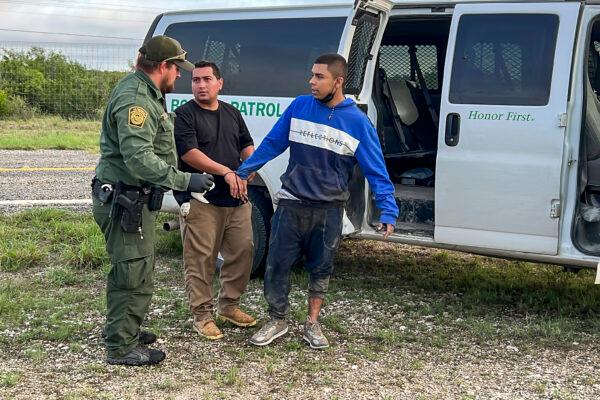At a hearing to discuss the technology needed to secure the nation’s borders, one Homeland Security official said that without one critical resource, all the technology in the world would be useless.
“Technology will never replace the men and women pursuing what the technology uncovers,” said Anthony Salisbury, acting deputy executive associate director for Homeland Security Investigations.
Salisbury and Diane Sabatino, deputy assistant commissioner, Office Field Operations for Customs and Border Protection, testified before the House Oversight Committee’s Subcommittee on National Security, the Border, and Foreign Affairs on March 8.
The subject of the hearing was “Force Multipliers: Examining the Need for Additional Resources to Disrupt Transnational Crime at the Border and Beyond.” While the committee did discuss technology, it was apparent that the committee is divided along party lines about the seriousness of the issue and who is to blame.
Rep. Paul Gosar (R-Ariz.) said he holds President Joe Biden responsible for the 6 million illegal immigrants that have reportedly crossed the southern border since he took office. Gosar said the border has come to mean nothing. As such, Mexico’s domestic crime problems are becoming the United States’ crime problems.

“The Mexican cartel problem is our problem. Americans deserve to know why the border issues are issues across the country,” Gosar said.
Rep. Robert Garcia (D-Calif.) said Biden had set aside $430 million for border security. According to Garcia, everyone wants the border secured, but it will take comprehensive immigration reform to solve the problem.
“The problems that we have today will not be solved just by border security and wall,” he said.
Committee Chairman Rep. Glenn Grothman (R-Wis.) doubted that U.S. law hindered legal migrants.
“Last year, we had 1 million (immigrants) sworn in legally. It’s not like no one can figure out how to get here legally,” he said.
Salisbury and Sabatino told the committee that the Mexican cartels are usually involved in illegal activity along the border. Salisbury said there is just too much money for them to stay away.
Salisbury said the cartels are simply recreating the template that has worked for them. They built their business model with marijuana and cocaine, then moved into methamphetamine production and human trafficking.

“They’re recreating their past,” Salisbury said. “They see dollar signs with fentanyl.”
Grothman said he is particularly concerned about fentanyl. He told the committee he had seen reports of an average of 107,000 Americans dying annually from drug overdoses. This is almost twice as many Americans as died in the Vietnam war.
Grothman opened the meeting with a demonstration of a CBP drug-detection dog. He said he had seen such a dog find fentanyl hidden in a gas tank full of fuel during a tour of the border.
Sabatino, whose agency handles the United States ports of entry, said the dogs are a valuable tool for securing American ports. She said the CBP is training more dogs and handlers, and hopes to have all ports covered by the dogs before the end of this fiscal year. Sabatino also answered some questions about a CBP app to streamline the asylum process.
The CBP One app is meant to provide a number of services for immigrants over the phone. The point is to streamline the immigration process and reduce the number of Border Patrol agents tied up with administrative tasks.
Rep. Alexandria Ocasio-Cortez (D-N.Y.) said she was told that facial recognition software in the app misidentified dark-skinned persons at a rate higher than others. She said the app appeared to be racially discriminatory.

“I’m very concerned about the implementation of that,” she said.
Ocasio-Cortez also asked Sabatino about those who did not have a cell phone or access to the internet.
Sabatino said her agency was aware of the issue and was working on it. She said the biometric software works as it was designed.
According to Sabatino, the problem was not the software but the network’s capacity along the border.
She said the misidentifications were due to an overload in the system. She said that the match rate is greater than 90 percent when the software is used on an adequate network. Sabatino said they are working with Mexican officials to explore ways to improve the internet services along the border.
She added that the app is only one tool the agency has.
“We do not conduct surveillance with the facial biometric technology,” she said.
Sabatino said the CBP is working with Salisbury’s agency, the FBI, and officials from other countries to make the ports of entry as secure as possible.

In the ports, CBP personnel are trained in what to look for when inspecting a vehicle or ship or talking with someone.
In addition to the drug-detection K9s, CBP uses what Sabatino called non-intrusive inspection technology to see inside possible hiding places.
She and Salisbury said the ultimate goal is to stop crimes where they start, in other countries, so they don’t make it to the border.
This means interdiction of the ingredients for fentanyl before they can be combined in Mexico. It means gathering and sharing intelligence on the cartels and others who would break our laws and having the tools necessary to keep bad actors far away from the United States.
“The ultimate goal is to push the transnational criminal organizations further away from the U.S. Border,” Salisbury said.





